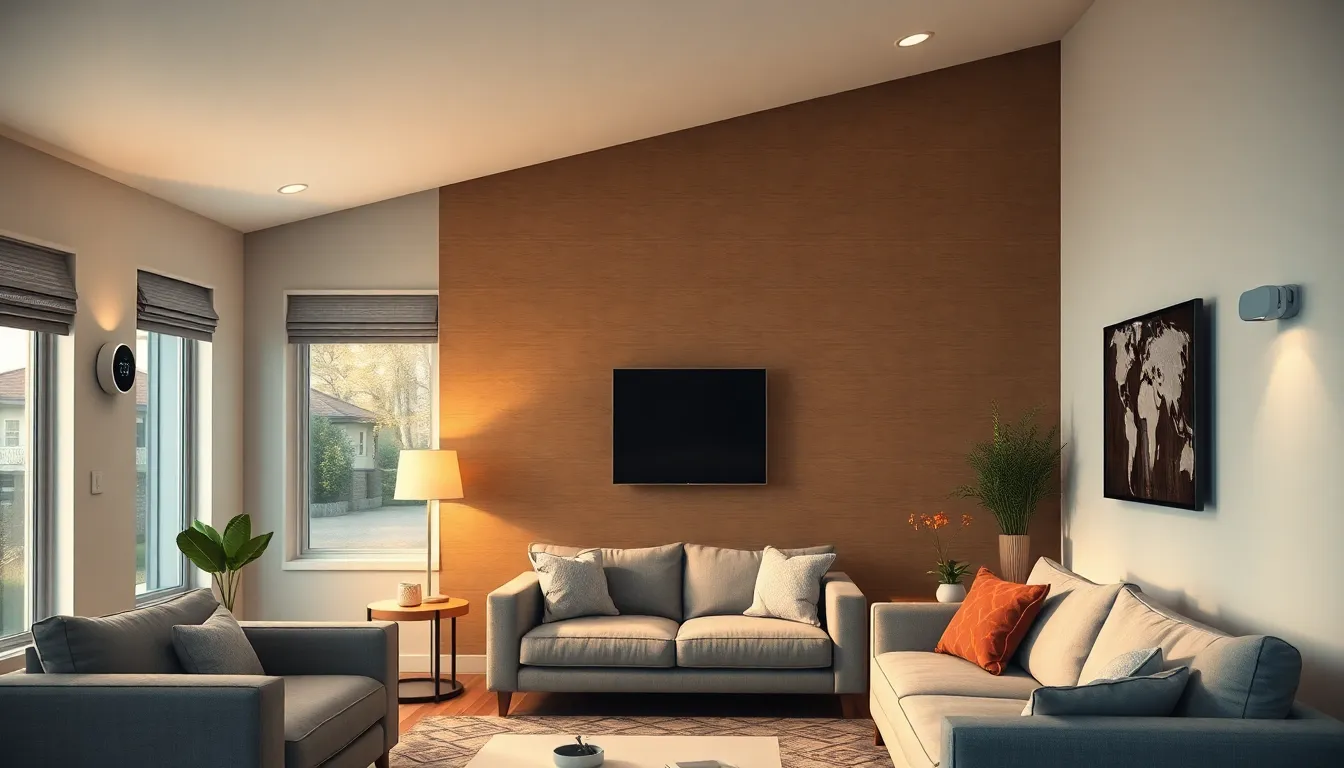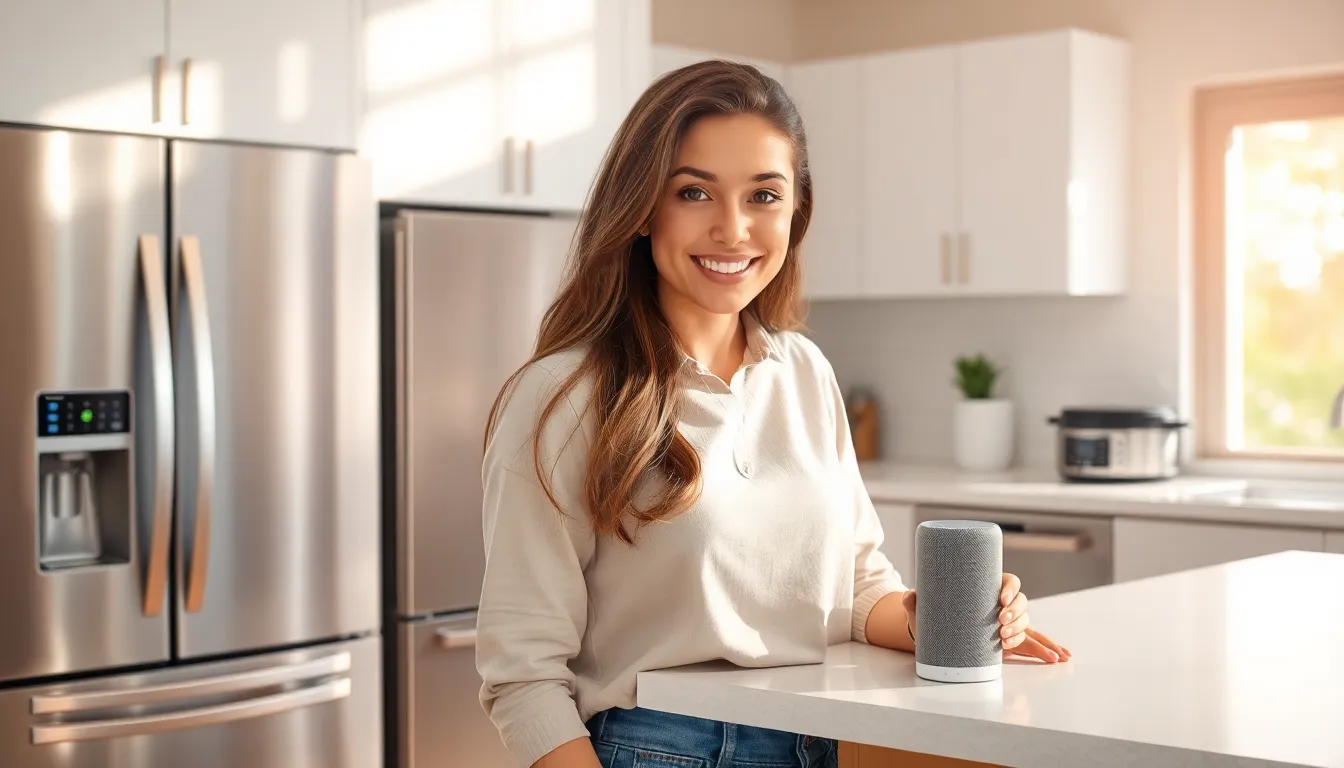Imagine walking into your home and having it greet you like a loyal butler, adjusting the lights just right and playing your favorite tunes. Smart home innovations are turning this dream into reality, making everyday life not just easier but also a tad more exciting. Gone are the days of fumbling for light switches or manually adjusting the thermostat. Now, your home can think for itself—well, sort of.
Table of Contents
ToggleOverview of Smart Home Innovations
Smart home innovations encompass a range of technologies designed to enhance daily living. Automated lighting systems adjust according to the time of day, providing convenience and energy efficiency. Voice-activated assistants streamline controls for various devices, allowing users to operate their homes using simple commands.
Temperature regulation occurs through smart thermostats that learn user preferences, creating optimal comfort while reducing energy waste. Security enhancements include smart cameras and doorbells equipped with motion detection, offering real-time alerts and remote access.
Smart appliances integrate with home networks, enabling cooking and cleaning tasks to be monitored or controlled from smartphones. Home entertainment systems streamline media accessibility, allowing users to enjoy personalized playlists and movie selections effortlessly.
Integration of smart sensors also plays a crucial role, detecting smoke, carbon monoxide, and water leaks to improve safety. Energy management systems provide insights into electricity usage, enabling better decisions to lower bills.
Connectivity between devices often creates a unified ecosystem, allowing seamless interaction and automation. For instance, lights can turn off automatically when a security system activates, enhancing both safety and convenience.
Notably, the continuous advancement in artificial intelligence fuels the evolution of smart home technology. Machine learning algorithms help devices become more intuitive over time, significantly improving user experience.
The combination of these technologies shapes a new standard in home living, offering enhanced control, security, and efficiency.
Types of Smart Home Innovations

Smart home innovations enhance convenience and security for everyday living. Various technologies contribute to making homes more efficient and user-friendly.
Smart Lighting Solutions
Smart lighting solutions provide automated control over illumination. Systems adjust brightness based on time of day or occupancy, increasing energy efficiency. Voice commands or mobile apps allow users to manage settings conveniently. Dimming features enhance ambiance according to preferences. Scheduling capabilities enable lights to turn on or off at specified times. Integration with motion sensors further automates lighting based on presence.
Advanced Security Systems
Advanced security systems deliver enhanced protection and peace of mind. Smart cameras grant homeowners real-time video access through mobile devices. Doorbell cameras notify users of visitors, allowing remote conversations. Alarm systems connect to smartphones for immediate alerts during breaches. Geofencing technology enables systems to activate or deactivate based on user location. Sensors detect unusual activity, triggering automatic notifications.
Intelligent Thermostats
Intelligent thermostats optimize energy use while maintaining comfort. These devices learn user habits and preferences, adjusting settings accordingly. Remote access via smartphones allows for real-time temperature modifications. Geolocation features detect when occupants are home or away. Adaptive scheduling provides personalized adjustments throughout the day. Energy reports inform users about usage patterns to promote savings.
Benefits of Smart Home Innovations
Smart home innovations provide significant advantages that transform everyday living. These advancements improve convenience, enhance energy efficiency, and bolster security within a home’s environment.
Increased Convenience
Smart home technology simplifies tasks and optimizes daily routines. Devices offer remote controls via smartphones, providing effortless access to home systems. Automated lighting adjusts based on ambient conditions, eliminating the need for manual adjustments. Voice-activated assistants streamline management by answering questions and controlling devices through simple commands. Scheduling features allow users to set regular tasks, like turning on lights or starting coffee makers. The seamless integration between devices creates a unified experience, ensuring that homes respond automatically to individual needs.
Improved Energy Efficiency
Energy management becomes more efficient through smart home systems. Smart thermostats learn user habits, adjusting temperature settings automatically for optimal comfort without wasting energy. Automated lighting systems can turn off when occupants leave a room, reducing unnecessary electricity usage. Monitoring tools track energy consumption, helping homeowners identify high usage periods and adjust habits for savings. Devices can also provide insights into usage patterns, supporting informed decisions about energy efficiency. Overall, smart home innovations contribute to reduced utility bills and a lower carbon footprint.
Enhanced Security
Security features in smart homes elevate safety and peace of mind. Smart cameras and doorbells provide real-time video access, allowing homeowners to monitor entrances remotely. Notifications alert occupants to unusual activities, enabling immediate responses to potential threats. Integration with home security systems allows for automated locking and unlocking based on user proximity. Sensors detect motion and environmental hazards, enhancing overall safety. With remote access to security systems, users gain complete control over their home’s security from anywhere, enhancing both safety and convenience.
Challenges and Considerations
Smart home innovations bring significant benefits, but they also present challenges that homeowners should consider. Understanding these concerns ensures the successful integration of smart technologies.
Privacy and Security Concerns
Privacy issues arise with the data collection practices of smart devices. Advanced features often require personal information for optimal functionality, potentially exposing sensitive data. They can be vulnerable to cyber attacks, leading to unauthorized access to home networks. Companies must prioritize robust encryption standards and transparent privacy policies to protect user information. Homeowners should regularly update device firmware and configure security settings to minimize risks. Staying informed about data usage and permissions enhances user awareness and trust.
Compatibility Issues
Compatibility challenges can complicate smart home setups. Not all devices communicate seamlessly due to varying protocols and standards. Selecting products from the same manufacturer typically reduces integration hurdles. Homeowners may face difficulties when integrating older devices with newer technology. Researching compatibility before purchases streamlines device interaction. Using platforms that support multiple brands can simplify management and enhance user experience. Addressing these concerns early on allows a cohesive smart home environment.
Smart home innovations are transforming the way people live by creating environments that are not only convenient but also energy-efficient and secure. As technology continues to evolve homeowners can expect even more intuitive systems that seamlessly integrate into daily life.
While the benefits are significant the importance of addressing privacy and compatibility issues cannot be overlooked. By prioritizing robust security measures and researching device compatibility homeowners can fully embrace the advantages of smart home technology.
Ultimately these advancements are setting a new standard for modern living making homes smarter and more responsive to individual needs.








